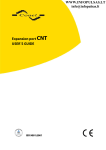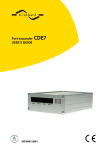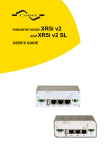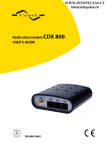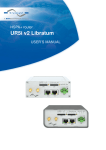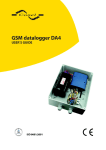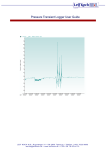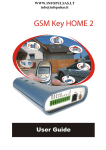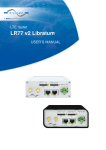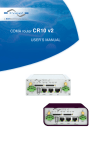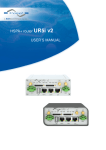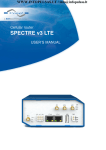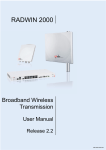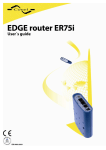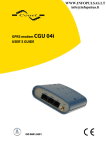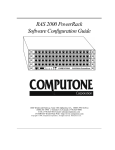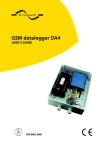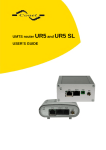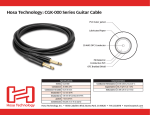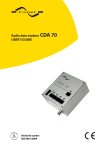Download 2. Description of the CGK 5 GSM key
Transcript
CONTENTS Contents 1. Safety instructions 2. Description of the CGK 5 GSM key 2.1. General description 2.2. Examples of using 2.3. Description of the individual parts of the CGK 5 2.3.1 Programmable GSM-GPRS module 2.3.2 Control microcontroller 2.3.3 Inputs and outputs 2.4. Technical parameters 2.5. Module state indication 2.6. User interfaces (connectors) 2.6.1 Connection of the COM connector 2.6.2 Connection of the IO connector 2.6.3 Connection of the supply PWR connector 2.6.4 Connection of the USB connector 2.7. Antenna connection 2.8. Power supply 2.9. Standard accessories 2.10. Mechanical external dimensions and mounting recommendations 2.11. Production label 3. CGK5 possibilities – firmware versions 3.1. GSM key application 3.2. AGNES application 3.3. Own JAVA application 3.4. Terminal 4. Reference 5. Links to related products of the manufacturer 5.1. Software 5.2. Products 6. Product disposal informations 7. Complaints procedure 8. Warranty 2 4 5 5 5 5 5 5 5 7 8 9 10 11 13 14 14 14 15 15 18 19 19 19 19 19 20 20 20 20 20 21 23 CONTENTS Symbols used Danger – important notice, which may have an influence on the user’s safety or the function of the device. Attention – notice on possible problems, which can arise in specific cases. Information, notice – information, which contains useful advices or interest notice. Conel s.r.o., Sokolska 71, 562 04 Usti nad Orlici, Czech Republic Issue in CZ, 05/08/08 3 SAFETY INSTRUCTIONS 1. Safety instructions Please, observe the following instructions: 1. The GSM key must be used in compliance with any and all applicable international and national laws and in compliance with any special restrictions regulating the utilization of the GSM key in prescribed applications and environments. 2. To prevent possible injury to health and damage to appliances and to ensure that all the relevant provisions have been complied with, use only the original accessories of the Conel company. Unauthorised modifications or utilization of accessories that have not been approved may result in damage to the GSM key and in a breach of applicable regulations. Unauthorized modifications or utilization of accessories that have not been approved may result in the termination of the validity of the guarantee, which, however, does not affect your legal rights. 3. The GSM key must not be opened. Only the replacement of the SIM card is permitted. 4. Caution! The SIM card could be swallowed by small children. 5. Voltage at the feed connector of the GSM key must not be exceeded. 6. Do not expose the GSM key to extreme ambient conditions. Protect the GSM key against dust, moisture and high temperature. 7. It is recommended that the GSM key should not be used at petrol stations. We remind the users of the duty to observe the restrictions concerning the utilization of radio devices at petrol stations, in chemical plants, or in the course of blasting works in which explosives are used . 8. When using the GSM key in close proximity of personal medical devices, such as cardiac pacemakers or hearing aids, you must proceed with heightened caution. 9. If it is in the proximity of TV sets, radio receivers and personal computers, the telephone may cause interference. 10. It is recommended that you should create an appropriate copy or backup of all the important settings that are stored in the memory of the device. 4 CGK 5 DESCRIPTION 2. Description of the CGK 5 GSM key 2.1. General description The CGK 5 is application which contain electronic device TC65 Communicator Java I/O with programmable GSM/GPRS module Siemens. The CGK 5 module is fitted with a Javabased control software which is used to data or RS232 serial port maintaining, control two output ports with relays and four optically separated input ports. Configuration of the CGK 5 module can be carried out through the RS-232 serial interface by means of the GSM key ADMIN [1] or RADWIN [2] service program. 2.2. Examples of using • • • • • GSM key – gates, motors or barrier controlling by mobile Alarms SMS detector from connected inputs (sensors) Technology remote control GPRS data transmition from industry, measurements and security devices GSM/GPRS terminal 2.3. Description of the individual parts of the CGK 5 2.3.1 Programmable GSM-GPRS module Wireless communication in the GSM network is carried out by means of the OEM module TC65 Java of the SIEMENS company. It has been incorporated directly in the printedcircuit board. The push-out holder of the SIM card reader is accessible from the front panel. The antenna connector is accessible from the rear panel. The TC65 module is suitable for communication in both GSM bands 850/900/1800/1900 MHz. The TC65 module is fitted with two serial interfaces, ASC0 and ASC1. The ASC1 interface has been brought out to the RJ45 connector, which is labelled COM. All the RS232 signals are protected against the over voltage coming through the data cable. The module TC65 contain interface USB2.0 full speed too, which is take out on USB connector of type 'B' under marking USB. For this interface it is delivered driver. The USB interface is not exploited by Java application. 2.3.2 Control microcontroller The CGK 5 communication module has been fitted with an 8-bit microcontroller that serves for starting and monitoring the TC65 module operation. The operating microcontroller is also used for monitoring the state of the supply voltage; if the supply voltage drops below 10,5 V, or 21 V, the operating microcontroller automatically turns off the TC65 module. The automatic turn-off of the TC65 module also occurs in the event that there is a minimally power supply 10,8 V, or 21,7 V. 2.3.3 Inputs and outputs Besides the service data and USB interface, an IO interface has been created in the CGK 5 module. This is a case of two pairs of signals, where two pairs represent the relay outputs (O1A+O1B and O2A+O2B), and four represent the separated inputs (I1, I2, I3, 5 CGK 5 DESCRIPTION I4) with common ground. The input I1 is possible use as counter input for counting with max. frequency 100 Hz and pulse ratio 10 to 50 %. Inputs and output circuits have been designed for voltage up to 30 V. Inputs Ix can use as counter input to counts with maximal frequency 500 Hz and with duty factor 1:1 for correct pulse recognise. Inputs and outputs circuits are concepts for voltage to 30 V. Logical levels limits LOG0 Vmin 0V LOG0 Vmax 2V LOG1 Vmin 4,5 V LOG1 Vmax 30 V Relay outputs Ox are acceptable only to static switching, maximally it can use to pulse generates with non guarantee length. For accurate pulses generate this output isn't acceptable. Output has parameters Imax = 0,5 A, Vmax = 30 V AC/DC a fmax = frequency of relay switching it is impossible accurate guarantees, it is considerably depends on software activity. 6 CGK 5 DESCRIPTION 2.4. Technical parameters GSM module SIEMENS TC65 Java Complying with the following standards: EN 301 511:v9.0.2 EN 55022:1998, A1:2000, A2:2003, Cor:2003 EN ISO/IEC 17025 EN 60 950-1:2001 EGSM900, EGSM 850 a GSM1800, GSM1900 Class 4 (2W) pro EGSM900 Class 1 (1W) pro GSM1800 -20 oC to +55 oC -40 oC to +85 oC 10,8 to 15,6 V DC 21,7 to 30 V DC 250 mW 3W 30x90x102 mm 150 g Din ribbon 35 mm FME – 50 Ohm RS232 – connector RJ45 (150 b/s - 115 200 b/ s) USB – connector of type B 2 relay outputs 4 binary inputs Frequency bands Transmission power Temperature range Function Storage Supply voltage Consumption Dimensions Weight Fixation Antenna connector User interface 7 Reception Sending COM USB2.0 O1, O2 I1, I2, I3, I4 CGK 5 DESCRIPTION 2.5. Module state indication The front panel of the module is fitted with six indicator lamps (LED) to provide information about the state of the module. LED P 8 Description Permanently off .................. no power supply Permanently on (> 1 min)... faulty function Slowly blinking (9:1)............ the module is not registered in the GSM infrastructure Slowly blinking (1:9)............ true function Fast blinking ....................... false PIN G Permanently on …………... faulty function Slightly flashing through ..... sending on the high frequency channel O1 Light is off…………....the O1A and O1B contacts are disconnect Light is on………..…. the O1A and O1B contacts are connect O2 Light is off…………....the O2A and O2B contacts are disconnect Light is on………..…. the O2A and O2B contacts are connect I1 Light is off…………... voltage between the I1 and GND contacts is lower than 2 V Light is on…………....voltage between the I1 and GND contacts is higher than 3 V I2 Light is off…………... voltage between the I2 and GND contacts is lower than 2 V Light is on…………....voltage between the I2 and GND contacts is higher than 3 V I3 Light is off…………... voltage between the I3 and GND contacts is lower than 2 V Light is on……………voltage between the I3 and GND contacts is higher than 3 V I4 Light is off…………... voltage between the I4 and GND contacts is lower than 2 V Light is on…………....voltage between the I4 and GND contacts is higher than 3 V CGK 5 DESCRIPTION 2.6. User interfaces (connectors) At the rear panel of the CGK 5 there are situated one MRT9 connector (IO), one RJ12 connector (PWR), and one connector FME, possibly SMA (ANT). The IO-labelled connector has two relay outputs and four inputs. The PWR-labelled connector is used for connecting the power supply adapter and for monitoring the state of the main power supply. The antenna is to be connected into the ANT-labelled connector. At the front panel of the module there is one RJ45 connector (COM) which is used for configuring the CGK 5 by means of the GSM key ADMIN [1] or RADWIN [2] service program a connector USB-B (USB). 9 CGK 5 DESCRIPTION 2.6.1 Connection of the COM connector The RJ45 panel socket. (RS232 – DCE – Data Communication Equipment) Pin Signal no. identification 1 2 3 4 5 6 7 8 RTS CTS DTR DSR GND RXD CD TXD Description Data flow direction Request To Send Clear To Send Data Terminal Ready Data Set Ready GROUND – signal ground Receive Data Carrier Detect Transmit Data Input Output Input Output Output Output Input Example of the GSM key connection to PC: COM USB Cable KD-2 ● 10 cable KD2 is connected to PC serial port (example COM1) GSM key CGK 5 CGK 5 DESCRIPTION 2.6.2 Connection of the IO connector Connector MRT9 Pin no. Signal identification 1 PWR 2 3 4 5 6 7 8 9 10 I1 I2 I3 I4 GND O1A O1B O2A O2B 11 Description Output for feeding other circuits (connected directly to the feeding system of the modem) Input (can to use as countig input) Input Input Input Signal and power supply ground Relay output Relay output Relay output Relay output CGK 5 DESCRIPTION Example of the equipment connected to GSM key IO connector input: Pin 1 – PWR Pin 2 – I1 Pin 3 – I2 Pin 4 – I3 Pin 5 – I4 Pin 6 – GND Pin 7 - O1A Pin 8 - O1B Pin 9 - O2A Pin 10 - O2B 12 GSM key CGK 5 CGK 5 DESCRIPTION 2.6.3 Connection of the supply PWR connector The RJ12 panel socket Pin no. Signal identification Description 1 +UN Positive pole of the DC supply voltage (10 to 30 V) 2 NC Signal not connected 3 NC Signal not connected 4 +UN Positive pole of the DC supply voltage (10 to 30 V) 5 GND Negative pole of the DC supply voltage 6 GND Negative pole of the DC supply voltage Example: + DC 13 Pin 1 – +UN Pin 2 – NC Pin 3 – NC Pin 4 – +UN Pin 5 – GND Pin 6 – GND GSM key CGK 5 CGK 5 DESCRIPTION 2.6.4 Connection of the USB connector The USB panel socket. Pin no. Signal identification Description 1 + UN 2 D- Data - 3 D+ Data + 4 GND Positive pole of the DC supply voltage (5 VDC) Negative pole of the DC supply voltage 2.7. Antenna connection The antenna is to be connected to the CGK 5 at the rear panel by means of the FME connector. 2.8. Power supply The CGK 45 requires DC supply of +10,8 V to +15,6 V or +21,7 V to +30 V. During reception, consumption is 250 mW. During data sending, peak consumption is 3 W To ensure correct functioning, the power supply unit must be able to supply the peak current of 500 mA. 14 CGK 5 DESCRIPTION 2.9. Standard accessories 1. RJ12 feed connector for the supply voltage lead-in cable. 2. RJ45 connectors used for creating the data cable. 3. Declaration of conformity. 4. Guarantee claim guidelines. 5. Guarantee certificate. 2.10. Mechanical external dimensions and mounting recommendations For majority applications with built-in modem in switch board it is possible recognize two sort of environment: ● nopublic and industry environment of low voltage with high interference, ● public environment of low voltage without high interference. For both this environments it is possible to mount modems to switch board, which it doesn't need to have no examination immunity or issues in connection with EMC according to EN 60439-1+A1. For compliance of EN 60439 - 1 + A1 specification it is necessary observe next assembly of the modem to the switch - board: ● round antenna we recommended to observe distance 6 cm from cables and metal surfaces on every side according to next picture because elimination of interferences, while using external antenna except switch-board it is necessary use fit over-voltage wardships (lightning arrester) behind mounting of modem on sheet-steel we recommended to use the external antenna, 15 CGK 5 DESCRIPTION 16 ● singles cables we recommended to bind to the one's bunch according to next picture, for this way guidee cables reads this limitation: • length of the bunch (combination of power supply and data cables) can be maximum 1,5 m, if length of data cables overreached 1,5 m or in the event of, that cable lead except switch - board, we recommended to use fit over - voltage wardships (lightning arrester) • with data cable it mustn't lead cable with reticular tension ~ 230 V/50 Hz • the signals you conduct by twisted pair to sensors ● before single connectors it must be well - kept space for handling with cables at pertinent linking and switching off of single cables, CGK 5 DESCRIPTION 17 ● for correct function of the modem we recommended to use in switch - board earthing distribution frame for earth of power supply of modem, data cables and antenna, ● circuitry of GSM key is on the following pictures. CGK 5 DESCRIPTION 2.11. Production label 18 CGK5 POSSIBILITIES 3. CGK5 possibilities – firmware versions 3.1. GSM key application GSM Key HOME version is appropriate for usage at family house and small companies up to 20 user's. User's administration and configuration is by mobile and SMS messages. GSM Key PROFI version is appropriate for usage at mid and big companies, offices, hotels and pensions with higher persons movement (over 20 user's). User's administration and configuration is by mobile and SMS messages or by SW application GSM key ADMIN [1] or RADWIN [2]. GSM key CGK-5 version Profi version Home Stored list of users in FLASH memory in SIM card Maximal number of users 300 200 Configurable rights of users for outputs control yes no Switching of outputs status by ringing yes no Event register yes (1000) - 3.2. AGNES application AGNES version is appropriate for industry wireless data transmition. One may simply imagine the CGK5 module as a protocol converter between the user device (PLC automatic, PC, data terminal, etc.) and GSM-GPRS infrastructure of a mobile network operator, it provides the user with possibility to communicate simply between all the systems. Apart from data transfers via GPRS the CGUK5 module enables ARNEP, Linka-LINE (TCP, UDP), MBUS-TCP or RDS92 protocols. New protocols, not supported by the communication module yet, can be implemented according to the customer’s needs. User's administration and configuration is by SW application GSM key ADMIN [1] or RADWIN [2]). 3.3. Own JAVA application To CGK5 is possible upload own JAVA firmware which is created by customer. This created firmware uses CGK5 hardware. More see [3]. 3.4. Terminal CGK5 is possible delivery without any application, and than used the CGK5 as terminal which is connected to PC or user's device. Costumer has connection directly with GSM/GPRS module which can control by standard AT commands via serial line. More about AT commands see [4]. 19 REFERENCE AND LINKS 4. Reference [1] Conel s.r.o.: GSM key ADMIN, 2008 [2] Conel s.r.o.: RADWIN Programme for control AGNES, 2008 [3] Conel s.r.o.: CGK5 Programmer guide, 2008 [4] Siemens AG: TC65_ATC_V03.000, 2008 5. Links to related products of the manufacturer Related products and materials with a reference can be found on the manufacturer’s website Conel company: www.conel.cz There are another links on Siemens company website, TC65 module: www.siemens.de www.siemens.com 5.1. Software RADWIN – the software provides for creation, installation and administration of AGNES system GPRS data networks. GSM Key ADMIN - the software provides for administration of GSM Key. 5.2. Products GSM Datalogger DA4 – GPRS modem. 6. Product disposal informations The WEEE (Waste Electrical and Electronic Equipment: 2002/96/EC) directive has been introduced to ensure that electrical/electronic products are recycled using the best available recovery techniques to minimise the impact on the environment. This product contains high quality materials and components which can be recycled. At the end of it’s life this product MUST NOT be mixed with other commercial waste for disposal. Check with the terms and conditions of your supplier for disposal information. 20 COMPLAINTS PROCEDURE 7. Complaints procedure Dear customer, The product you have purchased had passed manufacturer’s tests and its functions had been checked by our technician before sale. In case any defect shows up during the guarantee period that prevents normal use we ask you to follow the Complaints procedure when registering your claim. To make a possible complaint procedure easier please make sure when taking over the product your vendor has duly filled in all the relevant parts of the warranty, including date, seal and signature. This complaints procedure relates to the purchased products. This complaints procedure does not relate to the services provided. Guarantee period of the products Guarantee period of 24 months from the date of purchase is provided for the device, source, antenna, data cable and possible accessories. The date of purchase is at the same time date of takeover. Registering a claim It is necessary to register your claim at the vendor where the subject of the complaint has been purchased. The customer shall present duly filled warranty and the complete subject of the complaint. Subject of the complaint shall be presented in a condition adequate to that at the moment of purchase. Caution! The vendor is not responsible for keeping default settings or data saved in the subject of the complaint. The customer is obliged to clarify the defect or how it is displayed and what claim he intends to register. Processing the complaint The vendor shall provide a free remedy depending on particular conditions, or replace the subject of the complaint for a new product, or settle the matter in another manner in compliance with the Civil Code and the Act on consumer’s protection. As of the moment the claim is registered by the customer and the subject of the complaint is taken over by the vendor the guarantee period stops running. The guarantee period continues on the date of takeover of the repaired subject of the complaint or replaced faultless product by the customer, or should it not be taken over on the date the customer is obliged to take over the repaired or replaced product. In case the vendor replaces the subject of the complaint for a new product (including IMEI replacement) the original subject of the complaint becomes property of the vendor and the new product becomes property of the purchaser. Since takeover of the new product a new guarantee period starts. In the cases when the vendor settles the matter after agreement with the customer by replacement of the subject of the complaint for a faultless product the new guarantee expires. 1. After 12 months since the replaced product was taken over by the customer. 21 COMPLAINTS PROCEDURE 2. On the date when the original guarantee period (subject of the complaint) would have expired should it not have been replaced, whichever comes first. 3. The claim is deemed unsubstantiated when the defect is not found by the vendor processing the complaint or the defect is not covered by the guarantee under Article 3 of the procedure. 4. In case the claimed defect is not found and functionality is proven to the customer, the customer is obliged to pay demonstrable cost related to expert assessment of the claimed defect. 5. In case defect is found when processing the complaint that is not covered by the guarantee (extra-warranty repair), the vendor shall inform the customer and the customer shall inform the vendor whether he/she wishes to have the defect repaired for the price set. A protocol shall be made on exact conditions of the extra-warranty repair and signed by both the customer and the vendor. Should the customer not require remedy through an extra-warranty repair under the conditions, the device shall be returned to him/her after he/she pays the demonstrable cost of expert assessment. The guarantee does not cover defects incurred due to 1. Mechanical damage (fall and the like). 2. Use of inadequate, or not recommended sources and other accessories. 3. Connection of the product with non-standard accessories. 4. Installation or use of the product conflicting with the Manual or use for other purposes than usual for this type. 5. Improper manipulation, or an intervention of unauthorised person or other service than authorised by the manufacturer. 6. Effects of natural forces (flood, fire etc.) or other local phenomena (storm, overvoltage and the like). 7. Storage under unauthorised temperatures. 8. Operation in a chemically aggressive environment. Other conditions The fact that the subject of the complaint does not conform to parameters set for other similar product types shall not be considered a fault. To assess whether it is a case of covered fault the parameters stated in the technical documentation for the product are decisive. The guarantee expires in any case of changes to the subject of the complaint, or damaged or otherwise unreadable serial number. 22 WARRANTY 8. Warranty Device type Serial number Guarantee period (months) Vendor Date of purchase Seal of the vendor 23 WARRANTY 1 2 3 4 5 YES - NO YES - NO YES - NO YES - NO YES - NO Date of complaint registration Complaint protocol number Date of reception of the device in repair shop Date of finished repair Number of repair sheet Warranty repair New serial number of the device (IMEI) Notes Seal of the repair shop 24
























